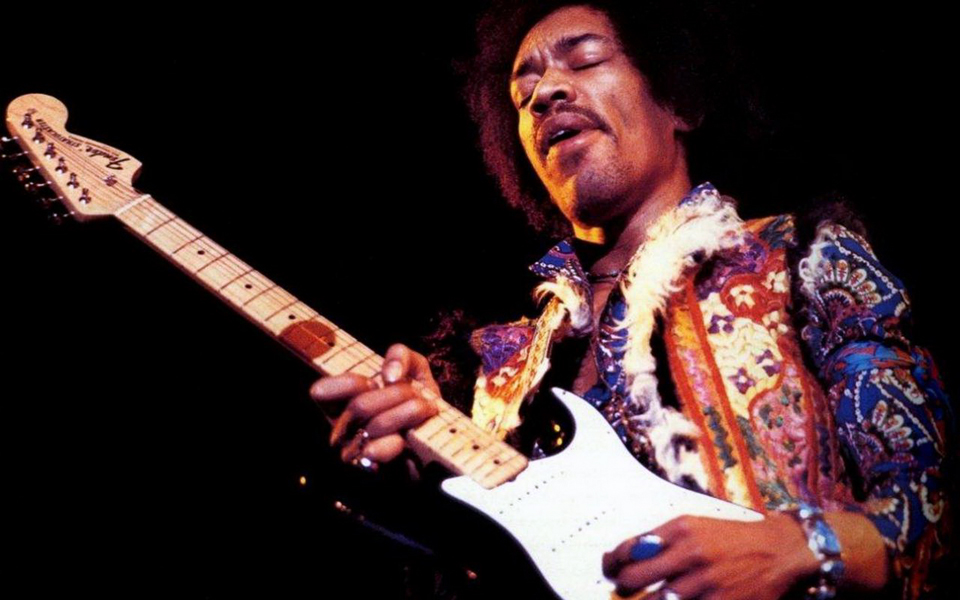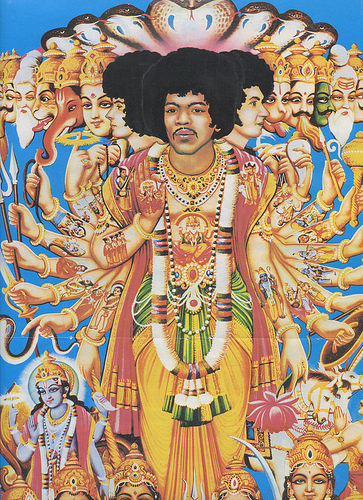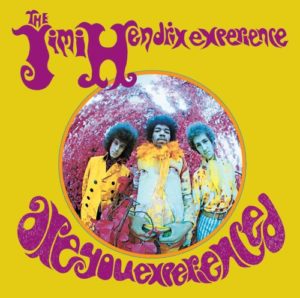It's about Time, Space and Jimi Hendrix
by John Diliberto 11/27/2017
We remember Jimi Hendrix on his 75th Birthday Tonight on Echoes.
Jimi Hendrix’s solo on “’Voodoo Chile” [Slight Return]’ it was like a Harley-Davidson screaming out of the sky.” –Conny Plank.
 75 years ago, genius fell to the earth when Johnny Allen Hendrix was born. Two name changes later, he became Jimi Hendrix, and he did nothing short of changing the world of music and guitar, in three short years, four earth-shattering albums and hundreds of concerts later, music was never the same.
75 years ago, genius fell to the earth when Johnny Allen Hendrix was born. Two name changes later, he became Jimi Hendrix, and he did nothing short of changing the world of music and guitar, in three short years, four earth-shattering albums and hundreds of concerts later, music was never the same.
Jimi Hendrix changed my life. When I heard “Purple Haze” come on AM radio in 1967, it was like a vortex sucking me into a world of color and motion like I’d never heard before. From the ferocious groove, distortion drenched solo and disembodied vocal, all beautifully articulating an acid trip.
I think he and Jeff Beck took the guitar to an expressive place and embraced feedback, controlled feedback, and various aleatoric sounds to a degree that pushed the guitar further expressively. –Wilco guitarist Nels Cline
Forty-seven years after his death and fifty since his debut album release, the sound of Jimi Hendrix only sounds more forward thinking than ever. He changed the sound of contemporary music. He didn’t necessarily invent distortion and signal processing, but he put such a personal stamp on it that things like wah-wah, fuzz-tone, controlled feedback and sustain will forever be identified with him. He brought in the sonics and techniques of the avant-garde, although I’m not sure he was actually exposed to avant-garde music at the time. But listen to his breaks on “Third Stone from the Sun” or the mid-section of “1983 (A Merman I Should Turn to Be).” It could’ve come right out of Karlheinz Stockhausen’s “Aus Den Sieben Tagen.”
As far as signal processing, we hear it today and it might not sound as unique as it really is. Because we’re used to hearing a lot of guitar players plug into a lot of boxes and play a lot of stuff, but that was groundbreaking. Things like the backwards guitar effect at the beginning of “Are You Experienced” that’s revolutionary to the point to where, yes, companied offer digital delays with a backwards option but nobody can use it without sounding like Jimi Hendrix. –Jeff Pearce
And of course, Hendrix got the backwards effect with tape manipulation since there was no digital in the 1960s. Almost all the electric guitarists you hear on Echoes are an outgrowth of Hendrix, whether it’s Jeff Pearce’s ambient guitar, Sigur Ros’ delay and reverb drenched distortions, Robert Fripp’s beautiful sustain or Terje Rypdal’s sculpted melodies. Hendrix is in every guitarist using distortion and signal processing.
Listening back to Hendrix’s albums, I was surprised at how short the tracks were. Most songs on the first two albums were under 3-minutes long. Yet in my mind, they were expansive electro-journey’s. Emerging from “Spanish Castle Magic’s” driving riff and screaming guitar chorus was like emerging from a great novel. You’d been transported to a strange land and had a miraculous adventure and everything now looked and sounded different. His songs distorted time and compressed experience.
 Putting together our Michael Hedge’s feature, I was struck about something guitarist Muriel Anderson said. “I didn’t really understand Michael Hedges music until I saw him live and I said ah, yes, the whole thing is a dance.”
Putting together our Michael Hedge’s feature, I was struck about something guitarist Muriel Anderson said. “I didn’t really understand Michael Hedges music until I saw him live and I said ah, yes, the whole thing is a dance.”
That was Hendrix. Music was motion and movement. Watch any of the live footage of Hendrix and you can see him swaying, bending, grimacing and embracing his guitar as the sound spirals like a shamanic ballet dancer. These days, a lot of those moves are standard rock guitarist histrionics, but when Hendrix executed them, they were part of the sound. He bent his body as his long fingers bent the notes of his guitar. And did he bend notes. Hendrix created the idea that a note, wasn’t just a note. It was a symphony of timbral and melodic changes screaming into the sky.
“I always thought of Jimi Hendrix as shamanistic and that’s why I felt he was unapproachable. And that’s also why he seems so at once very, very powerful, but also very vulnerable.” Wilco guitarist Nels Cline
And the gateway to his shamanistic world was LSD. Most of the documentaries on Hendrix fail to understand the psychedelic aspects of his music or, in films like the PBS American Masters documentary, Jimi Hendrix: Hear My Train a Comin’, pretty much ignore it. You don’t have to be tripping to enter Jimi Hendrix’s music. I was a fan of Hendrix for a decade before first ingesting psychedelics. But the LSD experience, (Are you?), is a key to understanding how Hendrix played with time, moved into newly discovered timbral worlds and created his sci-fi laced lyrics. Because LSD affects all those things. It alters your perception of time. You can spend an hour watching the progress of an ant, or see time extended out before you like a map in which any node is accessible. Acid plays with sound, creating echoes, delays, distortions and overtones. It takes you inside a sound, turning, as I said before, a note into a symphony.
I think the way he handled his guitar is totally different to most acts playing guitar that I ever see, rock stars if you like. He just like, he was just married to it. He was one with it. – Cosi Fanni Tutti of Throbbing Gristle
I got to see Hendrix live twice. Once in the summer of 1968 in Framingham, Massachusetts at the Carousel Theater with the original Experience of bassist Noel Redding and drummer Mitch Mitchell and again, shortly before his death in 1970 at the Boston Garden with Mitchell and bassist Billy Cox. The ’68 show was my first concert ever, but I still think I grasped its revelatory experience, the way Hendrix seemed to be tuning in into the universe while also being grounded in the earth, citing “Wild Thing” as the national anthem and already pointing to Noel Redding when he sang “’Scuse me while I kiss this guy” instead of “kiss the sky” on “Purple Haze. The audience consisted of serious listeners. When my friend and I stood for the national Anthem of “Wild Thing” we were told, in unambiguous terms, to sit down.
 By the time of the Boston Garden show, Hendrix was burnt out. His opening acts, Illusion and Cactus, were redundant carbon copies of his work, compared to The Soft Machine’s explorations opening the 1968 show. The audience was either distracted or rushed the stage. Hendrix himself seemed to be going through the motions and I swear, instead of playing his guitar to sound like “Thank You” it sounded more like “Fuck you.”
By the time of the Boston Garden show, Hendrix was burnt out. His opening acts, Illusion and Cactus, were redundant carbon copies of his work, compared to The Soft Machine’s explorations opening the 1968 show. The audience was either distracted or rushed the stage. Hendrix himself seemed to be going through the motions and I swear, instead of playing his guitar to sound like “Thank You” it sounded more like “Fuck you.”
“I see Hendrix as really kind of in a sad way, when I reflect on his trajectory and how he basically got gobbled up, and burned out and he had so many ideas that he couldn’t realize. I just recently read his journal entries and interviews in a book called Starting from Zero, [Starting at Zero: His Own Story] that he was hearing so much stuff in his head, it reminded me of reading about Coltrane’s later years and what he was striving for. Hearing something in your head that you just can’t quite get to and so it’s kind of driving you nuts.” –Nels Cline
I always wondered where Hendrix could go. While Electric Ladyland seemed pointed directly at the future, the posthumous release of the nearly completed Cry of Love seemed more restrained, especially rhythmically and structurally. The songs, with notable exceptions seem more pop oriented and barely go over 4-minutes in length and the sonics seem muted.
I wonder if Hendrix would’ve continued to explore or would he have become a funk or disco guitarist, maybe a bit of fuzak. I hope not. His performance at Woodstock the summer before his death certainly pointed in a direction of continued explorations and glorious guitar forays. That’s how I remember Hendrix. He pointed to the future, and I’m still living it thanks to his music.

Sometimes life is really Monday night. But every now and then you get evidence of magic. JimI was that. In the meeting with Mitch and Noel was also magic. Which had that sense of “swing”. There was just something magical about that mix.
That was a beautiful and eloquent remembrance, thank you. Especially nice coming from a peer who discovered Hendrix in the same time frame as I, at the beginning. Dead on regarding LSD, it definitely enhanced the creator and the listener. During a now legendary concert in Columbia, Md summer ‘68 at a ‘shed’ venue it began to rain. It quickly developed into a ferocious electrical storm at which point Hendrix literally started ‘jamming’ with the thunder and lightening, mimicking the sound in a ‘call and response’ sequence. Shamanic, yes very much so. Kudos again on a very well written piece.
Thank you!
Jimi’s “Third Rock from the Sun”has a hidden message. With headphones on and using the balance knobs put the turntable on 78rpms. You’ll hear our intergalactic traveler telling his home base that he’s found an inhabited planet. That’s all the Blaaaaa sound you hear at normal speed.
I’ll have to check that out. But, it’s Third Stone from the Sun” not “rock.” “3rd Rock from the Sun” was a TV comedy about. . . aliens on earth. 😉
What a Great album. I was so excited to let you know about Jimi’s hidden message hence “rock”. My band “Clancy” was playing in Vail, Co for a week in the winter of 68 when we found his secret on a portable record player. I hope you can let ever one else here it on your show. I saw them in Denver in 67.